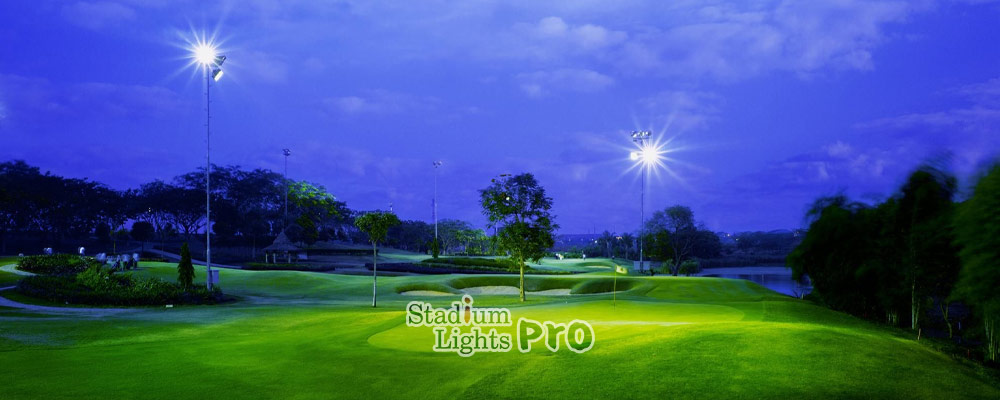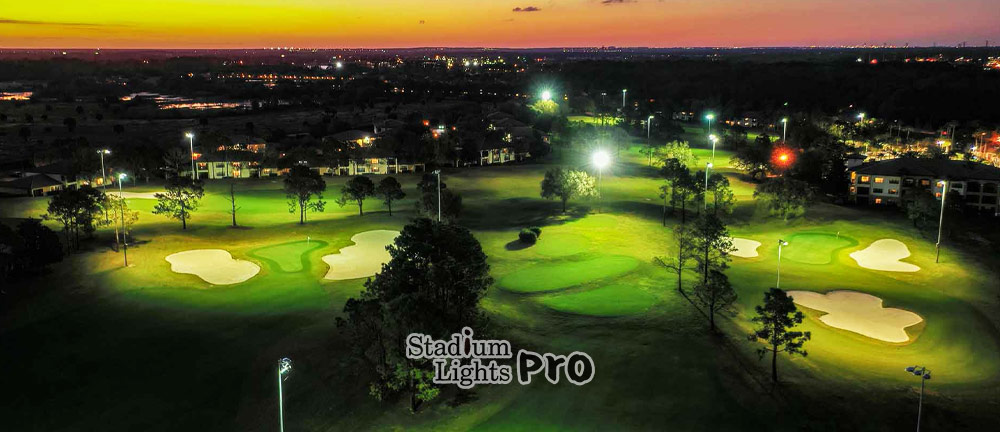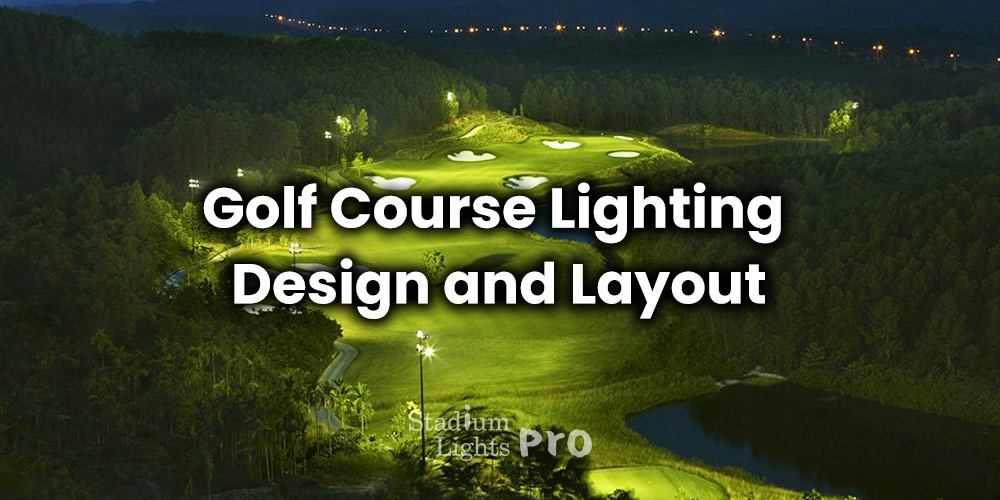Lighting is an essential aspect of the design and maintenance of a golf course. It serves several purposes, including:
- Enabling golfers to play the game safely and comfortably. Adequate lighting is essential for golfers to see the ball and the course, and to avoid obstacles and hazards. In fact, playing in low light can be difficult and tiring.
- Enhancing the appearance and aesthetics of the course. Proper lighting can highlight the natural beauty and features of the course, and create a pleasant and enjoyable atmosphere for golfers.
- Providing safety and security. Golf courses should be well-lit for the safety and security of golfers and staff. Lighting can deter potential burglaries or vandalism, and minimize the risk of accidents and injuries.
- Promoting the game. Good lighting can make the game more appealing and accessible to players, especially in the evenings or during the winter months when the days are shorter.
Table of Contents
ToggleThe challenges of lighting design in golf courses
There are several challenges that must be considered when designing the lighting system for a golf course. Some of these challenges include:
Brightness and visibility

The lighting system must provide sufficient brightness and visibility for golfers to play the game safely and comfortably. It should also be designed to minimize shadows and glare, which can affect the golfer’s ability to see the ball and the course.
Energy efficiency
Golf courses require a large amount of lighting, which can be costly in terms of energy consumption. Designers must consider energy-efficient options, such as LED lighting, to reduce energy costs and reduce the environmental impact of the lighting system.
Cost
The cost of installing and maintaining a golf course lighting system can be significant. Designers must carefully balance the need for effective lighting with the cost of the system.
Safety and security
Golf courses should be well-lit for the safety and security of golfers and staff. The lighting system must be designed to minimize the risk of accidents and injuries, as well as to deter potential burglaries or vandalism.
Environmental impact
The lighting system should be designed to minimize its impact on the surrounding environment, including the local flora and fauna. This may involve using low-energy or solar-powered lighting, or designing the lighting system to minimize light pollution.
Factors to consider in golf course lighting design

The layout and features of the course
The terrain and layout of the course
The lighting system should be designed to illuminate the fairways, greens, bunkers, and other features of the course in a way that is both effective and aesthetically pleasing. This may involve using different types of lighting fixtures, such as spotlights or floodlights, to highlight different features of the course.
The surrounding environment and vegetation
The lighting system should be designed to minimize the impact on the surrounding environment and vegetation. This may involve using low-energy or solar-powered lighting, or designing the lighting system to minimize light pollution.
The time of day and season
The lighting system should be designed to provide sufficient illumination at different times of the day and during different seasons. This may involve using different types of fixtures, such as LED lighting, which can be adjusted to different brightness levels.
The needs and preferences of golfers
The lighting system should be designed to meet the needs and preferences of golfers, such as the level of brightness and visibility required for different types of shots. It should also be designed to enhance the overall enjoyment and experience of the game for golfers.
The surrounding environment and vegetation
The surrounding environment and vegetation can significantly impact the design of the lighting system for a golf course. Some factors to consider include:
Light pollution
The lighting system should be designed to minimize light pollution, which can affect the local flora and fauna, as well as the enjoyment of the game for golfers. This may involve using fixtures that are designed to direct the light downward, rather than outward, and using shields or filters to reduce the amount of light that escapes.
Energy efficiency
The lighting system should be designed to minimize energy consumption, which can reduce the environmental impact of the course. This may involve using energy-efficient fixtures, such as LED lighting, or incorporating solar-powered lighting into the design.
Impact on the surrounding environment
The lighting system should be designed to minimize its impact on the surrounding environment, including the local flora and fauna. This may involve using fixtures that are designed to minimize light pollution, or designing the lighting system to minimize the amount of light that is directed towards neighboring properties or sensitive areas.
The layout and features of the course
The lighting system should be designed to illuminate the fairways, greens, bunkers, and other features of the course in a way that is both effective and aesthetically pleasing. This may involve using different types of lighting fixtures, such as spotlights or floodlights, to highlight different features of the course.
Maintenance and upkeep
The lighting system should be designed with maintenance and upkeep in mind. This may involve using fixtures that are easy to clean and replace, and incorporating systems for testing and monitoring the performance of the lighting system.
The needs and preferences of golfers
The level of brightness and visibility required for different types of shots
Golfers may have different preferences for the level of illumination and visibility required for different types of shots, such as approach shots, putts, and bunker shots. The lighting system should be designed to meet these needs, while also minimizing shadows and glare.
The overall enjoyment and experience of the game
The lighting system should be designed to enhance the overall enjoyment and experience of the game for golfers. This may involve using fixtures that are aesthetically pleasing, or designing the lighting system to highlight the natural beauty and features of the course.
The time of day and season
Golfers may have different preferences for the level of illumination and visibility at different times of the day, such as early in the morning, in the afternoon, or in the evening. The lighting system should be designed to meet these preferences.
Safety and security
The lighting system should be designed to provide a safe and secure environment for golfers to play the game. This may involve using fixtures that are positioned to minimize the risk of accidents and injuries, and designing the lighting system to deter potential burglaries or vandalism.
Types of lighting systems for golf courses

Floodlights
What lights are used in golf courses? Floodlights are a type of lighting fixture that is commonly used in golf course lighting systems. They are designed to provide a wide, even spread of light over a large area, and are typically mounted on poles or other structures. Floodlights are typically used to illuminate the fairways, greens, and other features of the course, and can be adjusted to different brightness levels and angles to suit the needs of the golfers.
Wide coverage
Floodlights provide a wide, even spread of light, making them suitable for illuminating large areas such as fairways and greens.
Adjustability
Floodlights can be adjusted to different brightness levels and angles, allowing them to be tailored to the specific needs of the golfers.
Durability
Floodlights are typically made from durable materials, such as aluminum or steel, and are designed to withstand the outdoor environment.
Energy efficiency
Modern floodlights may use energy-efficient technologies, such as LED lighting, to reduce energy consumption and costs.
Floodlights can be an effective and efficient choice for golf course lighting, but they may also have some limitations, such as a higher initial cost and the need for more maintenance and upkeep compared to other types of lighting fixtures.
Spotlights
Spotlights are designed to provide a concentrated beam of light over a small area, and are typically mounted on poles or other structures. Spotlights are typically used to highlight specific features of the course, such as bunkers or water hazards, and can be adjusted to different brightness levels and angles to suit the needs of the golfers.
Focused illumination
Spotlights provide a concentrated beam of light, making them suitable for highlighting specific features of the course.
Adjustability
Spotlights can be adjusted to different brightness levels and angles, allowing them to be tailored to the specific needs of the golfers.
Durability
Spotlights are typically made from durable materials, such as aluminum or steel, and are designed to withstand the outdoor environment.
Energy efficiency
Modern spotlights may use energy-efficient technologies, such as LED lighting, to reduce energy consumption and costs.
Spotlights can be an effective choice for golf course lighting, but they may also have some limitations, such as a higher initial cost and the need for more maintenance and upkeep compared to other types of lighting fixtures. They may also create shadows and glare if not positioned and adjusted properly.
LED lighting
LED lights are known for their energy efficiency, long lifespan, and low maintenance requirements. They are also highly durable and able to withstand the outdoor environment, making them a popular choice for golf course lighting.
Energy efficiency
LED lights use less energy than other types of lighting, which can help to reduce energy costs and the environmental impact of the golf course.
Long lifespan
LED lights have a longer lifespan than other types of lighting, which means they need to be replaced less frequently, resulting in lower maintenance costs.
Low maintenance
LED lights have low maintenance requirements, as they do not require frequent cleaning or replacement of bulbs.
Durability
LED lights are highly durable and able to withstand the outdoor environment, making them a reliable choice for golf course lighting.
Adjustability
LED lights can be adjusted to different brightness levels and colors, allowing them to be tailored to the specific needs of the golfers.
Solar-powered lighting
Solar-powered lighting is a sustainable and environmentally-friendly alternative to traditional electrical lighting, and is becoming increasingly popular in golf course lighting systems.
Sustainability
Solar-powered lighting uses renewable energy from the sun, making it a more sustainable and environmentally-friendly choice compared to traditional electrical lighting.
Energy efficiency
Solar-powered lighting systems do not require electrical power, which can help to reduce energy costs and the environmental impact of the golf course.
Low maintenance
Solar-powered lighting systems have low maintenance requirements, as they do not require frequent cleaning or replacement of bulbs.
Durability
Solar-powered lighting systems are highly durable and able to withstand the outdoor environment, making them a reliable choice for golf course lighting.
Cost-effectiveness
Solar-powered lighting systems may have a higher initial cost compared to traditional electrical lighting, but they can be more cost-effective in the long run due to their low energy consumption and maintenance requirements.
Layout and placement of lighting fixtures
Illumination levels and uniformity
The illumination level refers to the amount of light that is present in a given area, and should be sufficient to allow golfers to see the ball and the course, and to play the game safely and comfortably. The uniformity refers to the evenness of the light distribution, and should be designed to minimize shadows and glare, which can affect the golfer’s ability to see the ball and the course.
The lighting system should be designed to illuminate the fairways, greens, bunkers, and other features of the course in a way that is both effective and aesthetically pleasing. This may involve using different types of lighting fixtures, such as spotlights or floodlights, to highlight different features of the course.
Shadows and glare
Shadows can obscure the golfer’s view of the ball and the course, making it difficult to play the game safely and comfortably. Glare can also affect the golfer’s ability to see the ball and the course, and can be uncomfortable or even painful to the eyes.
The layout and features of the course
The lighting system should be designed to illuminate the fairways, greens, bunkers, and other features of the course in a way that is both effective and aesthetically pleasing. This may involve using different types of lighting fixtures, such as spotlights or floodlights, to highlight different features of the course.
The placement of lighting fixtures
The lighting fixtures should be positioned in a way that minimizes shadows and glare, while still providing sufficient illumination and visibility for the golfers. This may involve using fixtures that are angled or shielded to direct the light downward, rather than outward.
The use of filters or shields
Filters or shields can be used to reduce the amount of light that
escapes from the lighting fixtures, reducing the risk of glare and light pollution. This can be particularly essential when the lighting system is located near residential or sensitive areas.
Conclusion
Designing the lighting system for a golf course involves considering a range of factors, including the layout and features of the course, the surrounding environment and vegetation, the needs and preferences of golfers, and the time of day and season. Regular cleaning and maintenance of the lighting system can help to ensure that it is operating at its optimal level, and that the golf course is well-lit and enjoyable for golfers.
If you are in need of a new golf course lighting design or layout, we offer free customization and consultation services to help you create the perfect lighting system for your course. Our team of experienced lighting designers will work with you to understand your specific needs and preferences, and will use the latest technology and techniques to create a lighting solution that meets your budget and exceeds your expectations.
We pride ourselves on providing high-quality, energy-efficient lighting solutions that are tailored to the unique characteristics of your golf course. Contact us today to learn more and schedule your free consultation.

